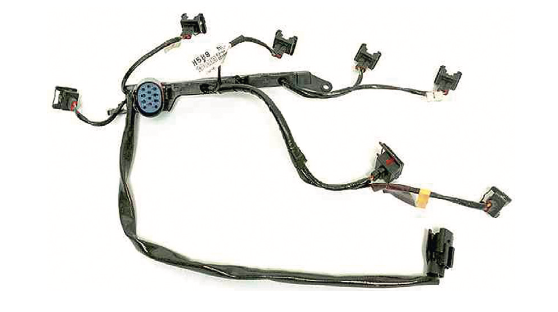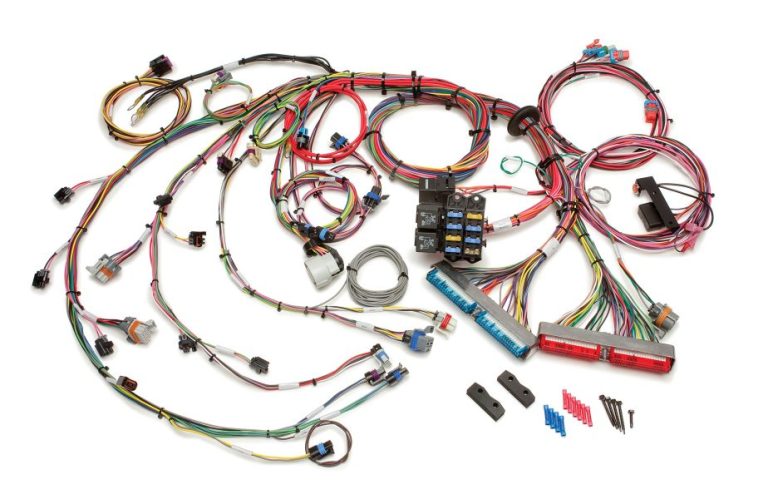An injection wiring harness is a key component of the engine management system in modern automobiles. It is a complex network of wires and connectors that connect various sensors and actuators to the engine control unit (ECU). In this blog post, we will explore what an injection wiring harness is, how it works, and why it is important for the smooth operation of your car.
What is an Injection Wiring Harness?
An injection wiring harness, also known as an engine wiring harness, is a bundle of wires that connects various electrical components in the engine bay of a car. It typically includes wires for sensors that measure various engine parameters, such as air flow, engine temperature, throttle position, and oxygen levels, as well as wires for actuators that control the fuel injection system, ignition system, and other engine functions.
How Does an Injection Wiring Harness Work?
The injection wiring harness works by transmitting electrical signals from the various sensors and actuators to the ECU. The ECU then uses this information to control the fuel injection system, ignition system, and other engine functions to optimize performance and fuel efficiency.
The injection wiring harness is designed to be highly durable and resistant to heat, vibration, and other environmental factors that can affect the operation of the engine. The wires are often color-coded and labeled to make it easier for mechanics to diagnose and repair any issues that may arise.
Why is an Injection Wiring Harness Important?
The injection wiring harness is an important component of the engine management system because it allows the various sensors and actuators to communicate with the ECU. Without a properly functioning injection wiring harness, the ECU would not be able to accurately measure and adjust various engine parameters, leading to reduced performance, lower fuel efficiency, and potential damage to the engine.

Additionally, the injection wiring harness plays a critical role in the safety of the vehicle. Faulty wiring can cause a variety of issues, such as incorrect sensor readings, which can lead to unsafe driving conditions. Therefore, it is important to ensure that the injection wiring harness is properly maintained and inspected regularly by a qualified mechanic.
In conclusion, the injection wiring harness is a critical component of the engine management system in modern automobiles. It connects various sensors and actuators to the ECU, allowing it to optimize engine performance and fuel efficiency. Proper maintenance and inspection of the injection wiring harness can help ensure safe and reliable operation of your vehicle.
The injection wiring harness is a complex network of wires and connectors that connects various electrical components in the engine bay of a car. The wires are typically made of copper or aluminum, which are good conductors of electricity, and are wrapped in insulation to protect against moisture, heat, and other environmental factors.
The injection wiring harness includes wires for a variety of sensors that measure various engine parameters, such as the air flow, engine temperature, throttle position, and oxygen levels. These sensors are crucial for providing the ECU with accurate information about the engine’s performance, which enables it to adjust the fuel injection system, ignition system, and other engine functions to optimize performance and fuel efficiency.
In addition to the sensor wires, the injection wiring harness also includes wires for various actuators that control the fuel injection system, ignition system, and other engine functions. These actuators include fuel injectors, spark plugs, and various valves that regulate air flow and other engine functions.
The injection wiring harness is designed to be highly durable and resistant to heat, vibration, and other environmental factors that can affect the operation of the engine. The wires are often color-coded and labeled to make it easier for mechanics to diagnose and repair any issues that may arise.
However, despite their durability, injection wiring harnesses can still suffer from wear and tear over time. The wires can become corroded or damaged, leading to faulty sensor readings or other issues that can affect the performance of the engine. It’s important to have the injection wiring harness inspected regularly by a qualified mechanic to ensure that it’s functioning properly.
In summary, the injection wiring harness is a critical component of the engine management system in modern automobiles. It connects various sensors and actuators to the ECU, enabling it to optimize engine performance and fuel efficiency. Proper maintenance and inspection of the injection wiring harness can help ensure safe and reliable operation of your vehicle.
Advantages:
- Improved engine performance: Injection wiring harnesses allow for more accurate monitoring of engine parameters, which in turn allows for more precise adjustments to be made to the fuel injection system, ignition system, and other engine functions. This can lead to improved engine performance and fuel efficiency.
- Reduced emissions: By enabling more precise adjustments to be made to the fuel injection system and other engine functions, injection wiring harnesses can help reduce harmful emissions from the engine.
- Increased reliability: Injection wiring harnesses are designed to be highly durable and resistant to environmental factors such as heat and vibration. This means that they are less likely to suffer from wear and tear than other components of the engine management system, which can improve the reliability of the vehicle.
- Easier diagnosis of issues: Injection wiring harnesses are often color-coded and labeled, which can make it easier for mechanics to diagnose and repair any issues that may arise. This can save time and money on repairs.
Disadvantages:
- Complexity: Injection wiring harnesses are complex networks of wires and connectors, which can make them more difficult and time-consuming to repair or replace than other components of the engine management system.
- Cost: Injection wiring harnesses can be expensive to replace, especially for more modern vehicles with more advanced engine management systems.
- Potential for failure: While injection wiring harnesses are designed to be highly durable, they can still suffer from wear and tear over time. If a wire or connector fails, it can cause issues with the engine’s performance or even result in engine damage if not addressed promptly.
- Limited flexibility: Injection wiring harnesses are designed to be specific to the engine management system of a particular vehicle, which means that they may not be easily adaptable to other vehicles or aftermarket upgrades.
In conclusion, injection wiring harnesses have several advantages, such as improved engine performance, reduced emissions, increased reliability, and easier diagnosis of issues. However, they also have some disadvantages, such as complexity, cost, potential for failure, and limited flexibility. Overall, injection wiring harnesses are a critical component of the engine management system in modern automobiles, and proper maintenance and inspection can help ensure safe and reliable operation of your vehicle.









